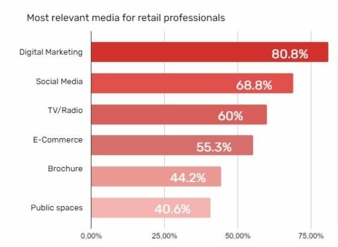07.02.22 – Retail
Retail trends that will prevail in 2022
Tiendeo, a company specialising in the digitization of the retail sector, has identified 5 key trends that will revolutionise retail in 2022.
2021 was a year of readjustment marked by a slow economic recovery, still engulfed by the Covid-19 pandemic. In this climate, the retail sector has adopted a flexible strategy that makes it easier to adjust to new consumer habits, causing marketers to reorganise their resources and distribution channels for 2022.
Tiendeo, a company specialising in the digitization of the retail sector, has identified 5 key trends that will revolutionise retail in 2022, based on a survey of marketers from the world’s leading brands and retailers.
1. Omnichannel experiences will continue to grow
According to the “Retail Marketing Hot Trends 2022” study conducted by Tiendeo, 58.6% of retailers and brands will be investing in digital channels in 2022. Changes in shopping habits have made the digital channel the preferred medium for marketers to connect with consumers. .
Likewise, investment in traditional media (TV, radio or outdoor advertising) has shifted to digital media. This is highlighted in the study where digital marketing (80.8%) along with social media (68.8%) will be the most prominent investments for marketing budgets in 2022.
Now more than ever, the use of adaptable strategies in the face of an uncertain future, together with the need to offer omnichannel experiences, will form the cornerstone of marketing strategies in 2022.
2. The rise of the “Experiential Store”
The concept of the traditional store is disappearing to make way for stores that offer experiences: stores that are able to combine the physical and digital worlds at a specific time and place.
A collateral effect of this change is the collapse of the shopping centre business model as we know it today. A business model that is in danger of disappearing in favour of a more flexible one, in which temporary or even one-off campaigns will become the norm. As a result, shopping centres will no longer just be places to spend time in, but will become meeting points where spaces will become stages, where different types of shows will be offered to encourage the consumption of a particular product or brand.
The objective of this change in business model is to attract the public to the store (both those who intend to buy and those who don't) and thus create a unique emotion-based experience that creates a greater connection and bond.
The customer shopping experience is the most important factor in consumer marketing strategy for 91.2% of professionals.
3. Technology as a catalyst for change
Mobile sales support solutions, interactive kiosks, checkout-free shops,... This will also be the future of retail. With the incorporation of technology and artificial intelligence into the sales process, we will see more and more smart stores, allowing consumers to shop in places that are virtually unmanned and where there is no checkout.
The German supermarket chain Edeka took the plunge by testing a new type of supermarket focused on autonomy and self-service: a fully automated robo-supermarket opened 24 hours a day where shoppers order on the go via app or on a touchscreen in the store. Another example is the supermarket Tegut, with the pilot project Teo, a fully digital self-service store that planify to open more supermarkets across Germany.
French retailers such as Carrefour, Auchan and Monoprix are also testing this new model. The development of this type of store allows retailers to compete with e-commerce giants by providing a more convenient and frictionless experience.
When it comes to online shopping, we will be taken to the store from the comfort of our own homes through augmented virtual reality. An example of this is Dyson, which is one of the first brands to test this concept with the opening of its own virtual store, where users are invited to try their products remotely and thus initiate the purchasing process.
4. The circular economy will be at the core of our strategies
Consumer concern for the environment is driving retailers and brands to adopt a more environmentally responsible strategy. Zero waste, second-hand and used markets will continue to grow as they address a crucial issue for the sector in 2022: reconciling purchasing power and environmental protection.
Another noteworthy feature in relation to the circular economy is the firm commitment of several retailers to reduce or eliminate the production of their paper catalogues. More and more retailers are opting for more sustainable communication tools such as digital catalogues.
5. Long live Social Shopping
Although social shopping is already a well-established trend, in 2022 we will see more and more brands and retailers using this medium as a complement to e-commerce, where social selling will rely mainly on influencers and brand ambassadors.
According to the Tiendeo study, 58% of retailers and brands intend to increase their advertising investments on social networks in the next 12 months.
- The study was conducted based on the opinion of 358 directors and managers of brands and retailers in the consumer sector, in digital marketing, trade marketing, e-commerce and omnichannel retail positions, in the categories of supermarkets, home, fashion, electronics, beauty, toys, restaurants, automotive, DIY, pets, sports, health and travel, between 8th November, 2021 and 13th December, 2021.


